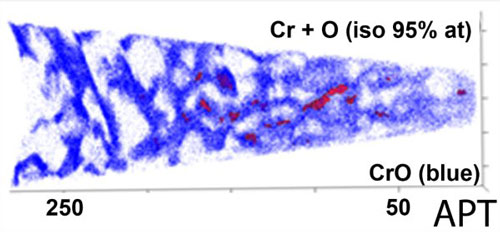| Oct 11, 2011 |
Helping materials handle extreme stress
|
|
(Nanowerk News) Important pressurized water nuclear reactor components are being made from a nickel-base alloy that contains twice the amount of chromium as the material previously used. The new alloy, called alloy 690, performs better, with no cracking due to corrosion in the high-temperature water service environment. However, stress corrosion cracking has been observed in lab tests on highly deformed alloy 690 material. To gain insights into this behavior, researchers at Pacific Northwest National Laboratory performed high-resolution investigations of corrosion and cracking processes.
|
|
Surprisingly, they found veins of localized oxidation wormed their way into the alloy 690 instead of forming the expected, chromium-rich protective oxide layer on the surface.
|
|
Even higher resolution images of corroded alloy 690 revealed the unique three-dimensional structure in the veins of oxidation. The filamentary veins were only about 5 nanometers in diameter, but penetrate to depths more than 400 nanometers below the surface. These veins contained a line of chromium oxide platelets surrounded by mixed nickel-chromium-iron oxide nanocrystals.
|
 |
|
Why It Matters: Researchers have long thought that a continuous and tenacious surface oxide layer protects metallic alloys from degradation in corrosive environments. But the veins of penetrative oxidation in the better-performing, high-chromium alloy raise fundamental questions about the mechanisms of corrosion and cracking. Understanding the sequence of events that result in penetrative oxidation will help researchers tailor alloys to be more resistant to degradation in service. This work might ultimately lead to longer-lasting components and safer nuclear reactors.
|
|
Methods: The researchers first evaluated corrosion and cracking in alloy 690 exposed to simulated pressurized water reactor primary water at temperatures from 325 to 360 degrees C. They then characterized the general morphology of these structures using low kV scanning electron microscopy and backscattered electron imaging. For higher resolution images and phase identification, transmission electron microscopy (TEM) was employed including energy filtered TEM and electron diffraction to elucidate the elemental distribution and phases throughout the penetrative oxidation. Finally, they used atom probe tomography in EMSL to determine the three-dimensional structure of the penetrative oxidation and examine solid-state diffusion processes leading the oxidation.
|
|
What's Next: The researchers are reproducing this oxidation on high-purity, nickel-chromium binary alloys of variable compositions to isolate surface and internal oxidation processes. They will be modifying computer models of corrosion to simulate the penetrative oxidation. Experimental data will allow them to verify the accuracy of computer models that can predict how nuclear reactor components corrode and crack during long-time service.
|
|
Research Team: Matthew J. Olszta, Daniel K. Schreiber, Larry E. Thomas and Stephen M. Bruemmer, PNNL.
|
|
Reference: Olszta MJ, DK Schreiber, LE Thomas and SM Bruemmer. 2011. "Penetrative Internal Oxidation from Alloy 690 Surfaces and Stress Corrosion Crack Walls during Exposure to PWR Primary Water." Proceedings of the 15th International Conference on Environmental Degradation of Materials in Nuclear Power Systems—Water Reactors, The Minerals, Metals and Materials Society, Colorado Springs, Colorado.
|

